Change Leadership Management Report - Merger Challenges Analysis
VerifiedAdded on 2022/10/09
|10
|2617
|15
Report
AI Summary
This report, prepared for a leadership management assignment, analyzes the challenges of a proposed merger between two organizations. As an operations manager, the report advises the CEO and management team on strategies to overcome potential obstacles. It identifies different types of change, including organizational culture, structural, and strategic adjustments, and highlights potential 'soft factor' challenges like communication breakdowns, lack of collaboration, and missing purpose. The report then applies the Kubler-Ross model to evaluate individual reactions to change, offering strategies to address denial, anger, bargaining, depression, and acceptance. Furthermore, it assesses potential organizational barriers such as lack of executive support and inadequate change management, recommending a structured communication approach to ensure a successful merger outcome. The report emphasizes the importance of clear communication, stakeholder engagement, and proactive planning to mitigate risks and achieve the merger's objectives.
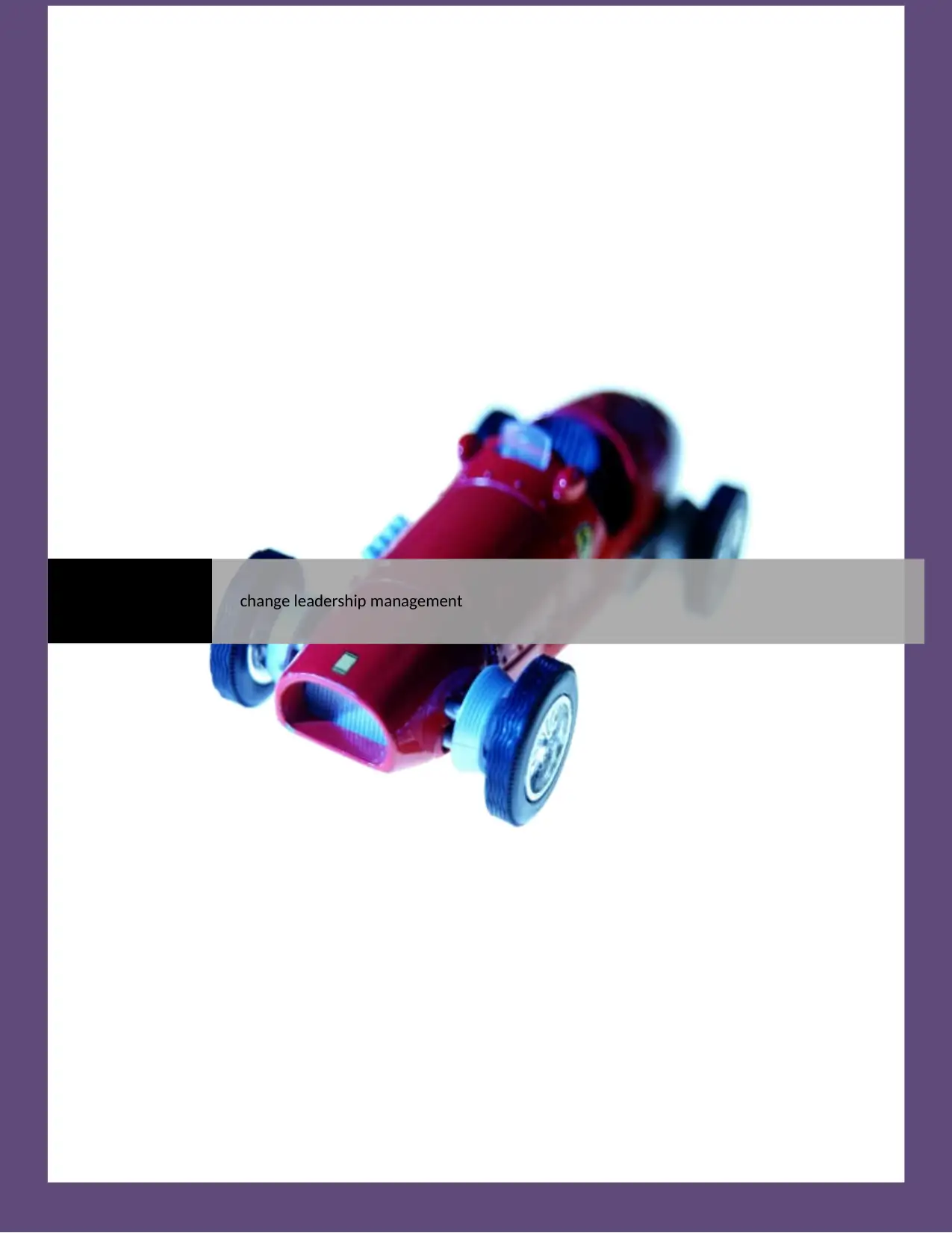
change leadership management
Paraphrase This Document
Need a fresh take? Get an instant paraphrase of this document with our AI Paraphraser
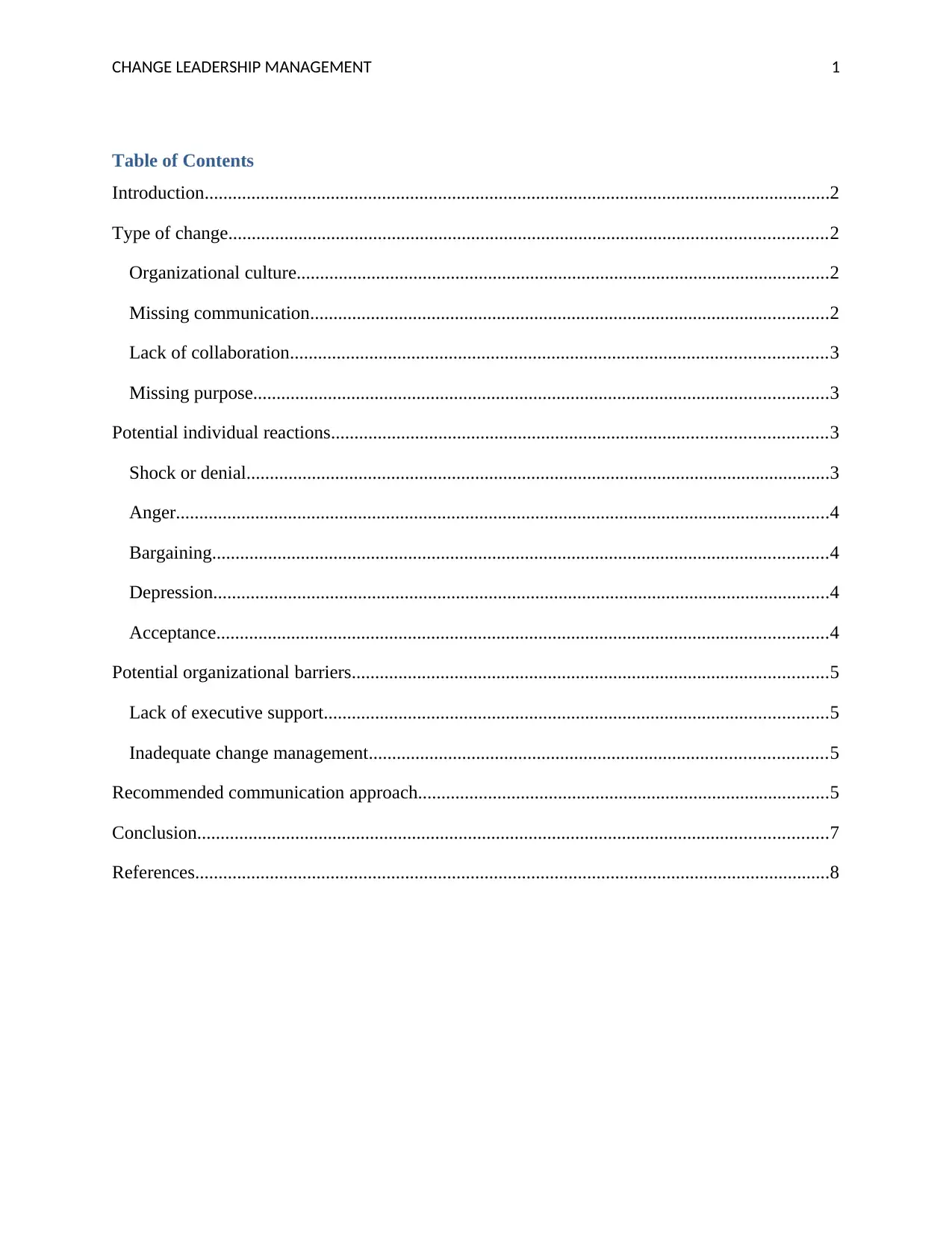
CHANGE LEADERSHIP MANAGEMENT 1
Table of Contents
Introduction......................................................................................................................................2
Type of change................................................................................................................................2
Organizational culture..................................................................................................................2
Missing communication...............................................................................................................2
Lack of collaboration...................................................................................................................3
Missing purpose...........................................................................................................................3
Potential individual reactions..........................................................................................................3
Shock or denial.............................................................................................................................3
Anger............................................................................................................................................4
Bargaining....................................................................................................................................4
Depression....................................................................................................................................4
Acceptance...................................................................................................................................4
Potential organizational barriers......................................................................................................5
Lack of executive support............................................................................................................5
Inadequate change management..................................................................................................5
Recommended communication approach........................................................................................5
Conclusion.......................................................................................................................................7
References........................................................................................................................................8
Table of Contents
Introduction......................................................................................................................................2
Type of change................................................................................................................................2
Organizational culture..................................................................................................................2
Missing communication...............................................................................................................2
Lack of collaboration...................................................................................................................3
Missing purpose...........................................................................................................................3
Potential individual reactions..........................................................................................................3
Shock or denial.............................................................................................................................3
Anger............................................................................................................................................4
Bargaining....................................................................................................................................4
Depression....................................................................................................................................4
Acceptance...................................................................................................................................4
Potential organizational barriers......................................................................................................5
Lack of executive support............................................................................................................5
Inadequate change management..................................................................................................5
Recommended communication approach........................................................................................5
Conclusion.......................................................................................................................................7
References........................................................................................................................................8
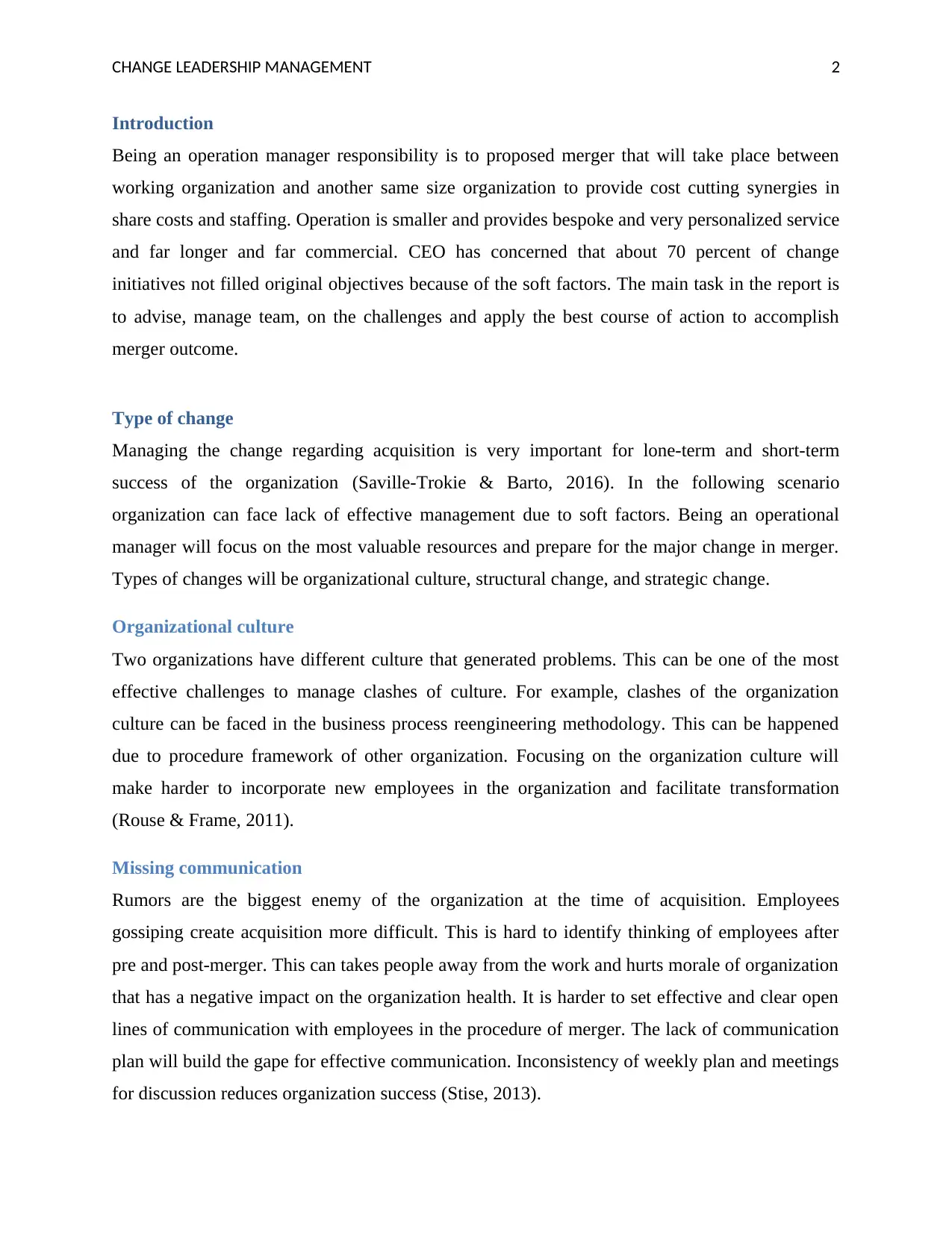
CHANGE LEADERSHIP MANAGEMENT 2
Introduction
Being an operation manager responsibility is to proposed merger that will take place between
working organization and another same size organization to provide cost cutting synergies in
share costs and staffing. Operation is smaller and provides bespoke and very personalized service
and far longer and far commercial. CEO has concerned that about 70 percent of change
initiatives not filled original objectives because of the soft factors. The main task in the report is
to advise, manage team, on the challenges and apply the best course of action to accomplish
merger outcome.
Type of change
Managing the change regarding acquisition is very important for lone-term and short-term
success of the organization (Saville-Trokie & Barto, 2016). In the following scenario
organization can face lack of effective management due to soft factors. Being an operational
manager will focus on the most valuable resources and prepare for the major change in merger.
Types of changes will be organizational culture, structural change, and strategic change.
Organizational culture
Two organizations have different culture that generated problems. This can be one of the most
effective challenges to manage clashes of culture. For example, clashes of the organization
culture can be faced in the business process reengineering methodology. This can be happened
due to procedure framework of other organization. Focusing on the organization culture will
make harder to incorporate new employees in the organization and facilitate transformation
(Rouse & Frame, 2011).
Missing communication
Rumors are the biggest enemy of the organization at the time of acquisition. Employees
gossiping create acquisition more difficult. This is hard to identify thinking of employees after
pre and post-merger. This can takes people away from the work and hurts morale of organization
that has a negative impact on the organization health. It is harder to set effective and clear open
lines of communication with employees in the procedure of merger. The lack of communication
plan will build the gape for effective communication. Inconsistency of weekly plan and meetings
for discussion reduces organization success (Stise, 2013).
Introduction
Being an operation manager responsibility is to proposed merger that will take place between
working organization and another same size organization to provide cost cutting synergies in
share costs and staffing. Operation is smaller and provides bespoke and very personalized service
and far longer and far commercial. CEO has concerned that about 70 percent of change
initiatives not filled original objectives because of the soft factors. The main task in the report is
to advise, manage team, on the challenges and apply the best course of action to accomplish
merger outcome.
Type of change
Managing the change regarding acquisition is very important for lone-term and short-term
success of the organization (Saville-Trokie & Barto, 2016). In the following scenario
organization can face lack of effective management due to soft factors. Being an operational
manager will focus on the most valuable resources and prepare for the major change in merger.
Types of changes will be organizational culture, structural change, and strategic change.
Organizational culture
Two organizations have different culture that generated problems. This can be one of the most
effective challenges to manage clashes of culture. For example, clashes of the organization
culture can be faced in the business process reengineering methodology. This can be happened
due to procedure framework of other organization. Focusing on the organization culture will
make harder to incorporate new employees in the organization and facilitate transformation
(Rouse & Frame, 2011).
Missing communication
Rumors are the biggest enemy of the organization at the time of acquisition. Employees
gossiping create acquisition more difficult. This is hard to identify thinking of employees after
pre and post-merger. This can takes people away from the work and hurts morale of organization
that has a negative impact on the organization health. It is harder to set effective and clear open
lines of communication with employees in the procedure of merger. The lack of communication
plan will build the gape for effective communication. Inconsistency of weekly plan and meetings
for discussion reduces organization success (Stise, 2013).
⊘ This is a preview!⊘
Do you want full access?
Subscribe today to unlock all pages.

Trusted by 1+ million students worldwide
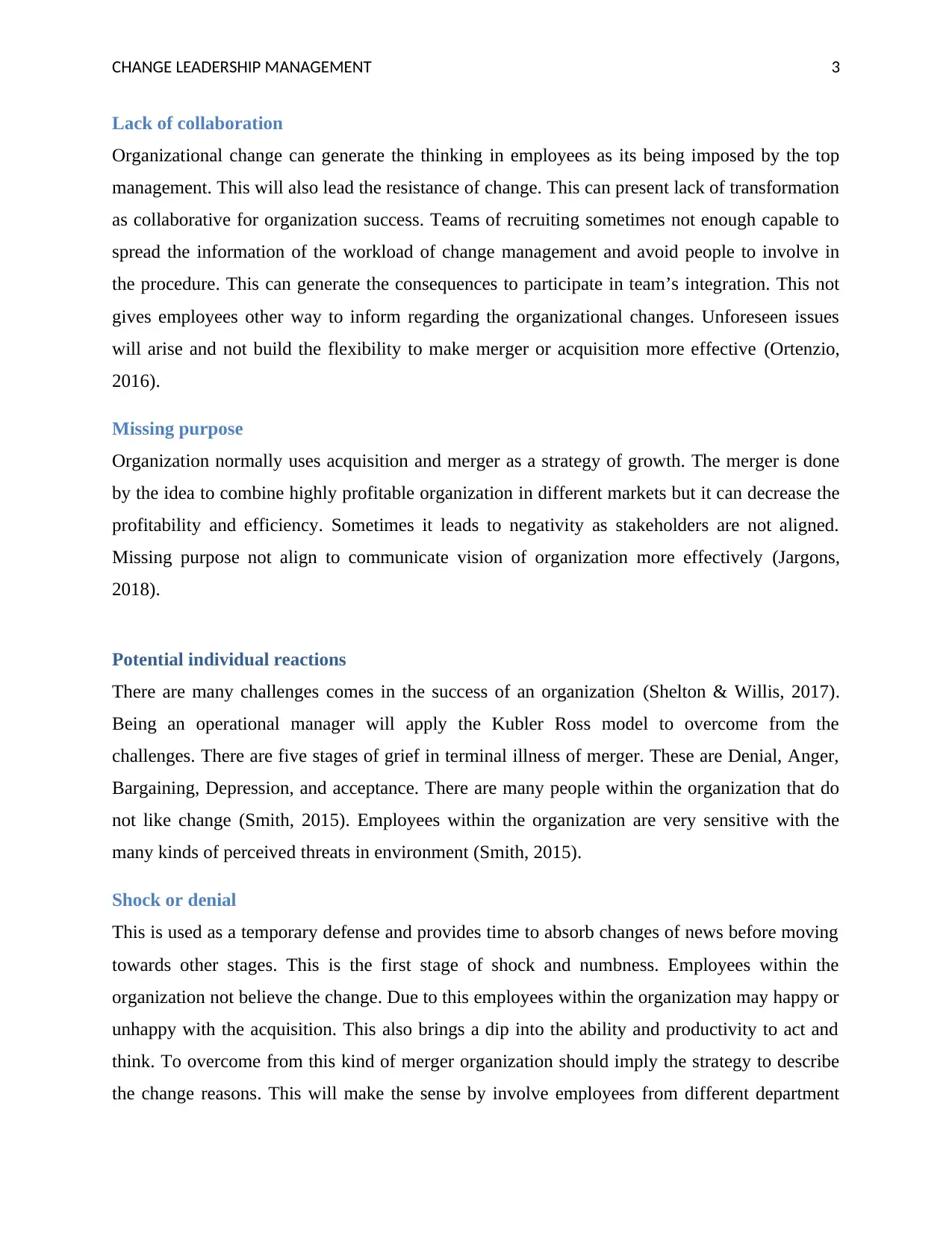
CHANGE LEADERSHIP MANAGEMENT 3
Lack of collaboration
Organizational change can generate the thinking in employees as its being imposed by the top
management. This will also lead the resistance of change. This can present lack of transformation
as collaborative for organization success. Teams of recruiting sometimes not enough capable to
spread the information of the workload of change management and avoid people to involve in
the procedure. This can generate the consequences to participate in team’s integration. This not
gives employees other way to inform regarding the organizational changes. Unforeseen issues
will arise and not build the flexibility to make merger or acquisition more effective (Ortenzio,
2016).
Missing purpose
Organization normally uses acquisition and merger as a strategy of growth. The merger is done
by the idea to combine highly profitable organization in different markets but it can decrease the
profitability and efficiency. Sometimes it leads to negativity as stakeholders are not aligned.
Missing purpose not align to communicate vision of organization more effectively (Jargons,
2018).
Potential individual reactions
There are many challenges comes in the success of an organization (Shelton & Willis, 2017).
Being an operational manager will apply the Kubler Ross model to overcome from the
challenges. There are five stages of grief in terminal illness of merger. These are Denial, Anger,
Bargaining, Depression, and acceptance. There are many people within the organization that do
not like change (Smith, 2015). Employees within the organization are very sensitive with the
many kinds of perceived threats in environment (Smith, 2015).
Shock or denial
This is used as a temporary defense and provides time to absorb changes of news before moving
towards other stages. This is the first stage of shock and numbness. Employees within the
organization not believe the change. Due to this employees within the organization may happy or
unhappy with the acquisition. This also brings a dip into the ability and productivity to act and
think. To overcome from this kind of merger organization should imply the strategy to describe
the change reasons. This will make the sense by involve employees from different department
Lack of collaboration
Organizational change can generate the thinking in employees as its being imposed by the top
management. This will also lead the resistance of change. This can present lack of transformation
as collaborative for organization success. Teams of recruiting sometimes not enough capable to
spread the information of the workload of change management and avoid people to involve in
the procedure. This can generate the consequences to participate in team’s integration. This not
gives employees other way to inform regarding the organizational changes. Unforeseen issues
will arise and not build the flexibility to make merger or acquisition more effective (Ortenzio,
2016).
Missing purpose
Organization normally uses acquisition and merger as a strategy of growth. The merger is done
by the idea to combine highly profitable organization in different markets but it can decrease the
profitability and efficiency. Sometimes it leads to negativity as stakeholders are not aligned.
Missing purpose not align to communicate vision of organization more effectively (Jargons,
2018).
Potential individual reactions
There are many challenges comes in the success of an organization (Shelton & Willis, 2017).
Being an operational manager will apply the Kubler Ross model to overcome from the
challenges. There are five stages of grief in terminal illness of merger. These are Denial, Anger,
Bargaining, Depression, and acceptance. There are many people within the organization that do
not like change (Smith, 2015). Employees within the organization are very sensitive with the
many kinds of perceived threats in environment (Smith, 2015).
Shock or denial
This is used as a temporary defense and provides time to absorb changes of news before moving
towards other stages. This is the first stage of shock and numbness. Employees within the
organization not believe the change. Due to this employees within the organization may happy or
unhappy with the acquisition. This also brings a dip into the ability and productivity to act and
think. To overcome from this kind of merger organization should imply the strategy to describe
the change reasons. This will make the sense by involve employees from different department
Paraphrase This Document
Need a fresh take? Get an instant paraphrase of this document with our AI Paraphraser
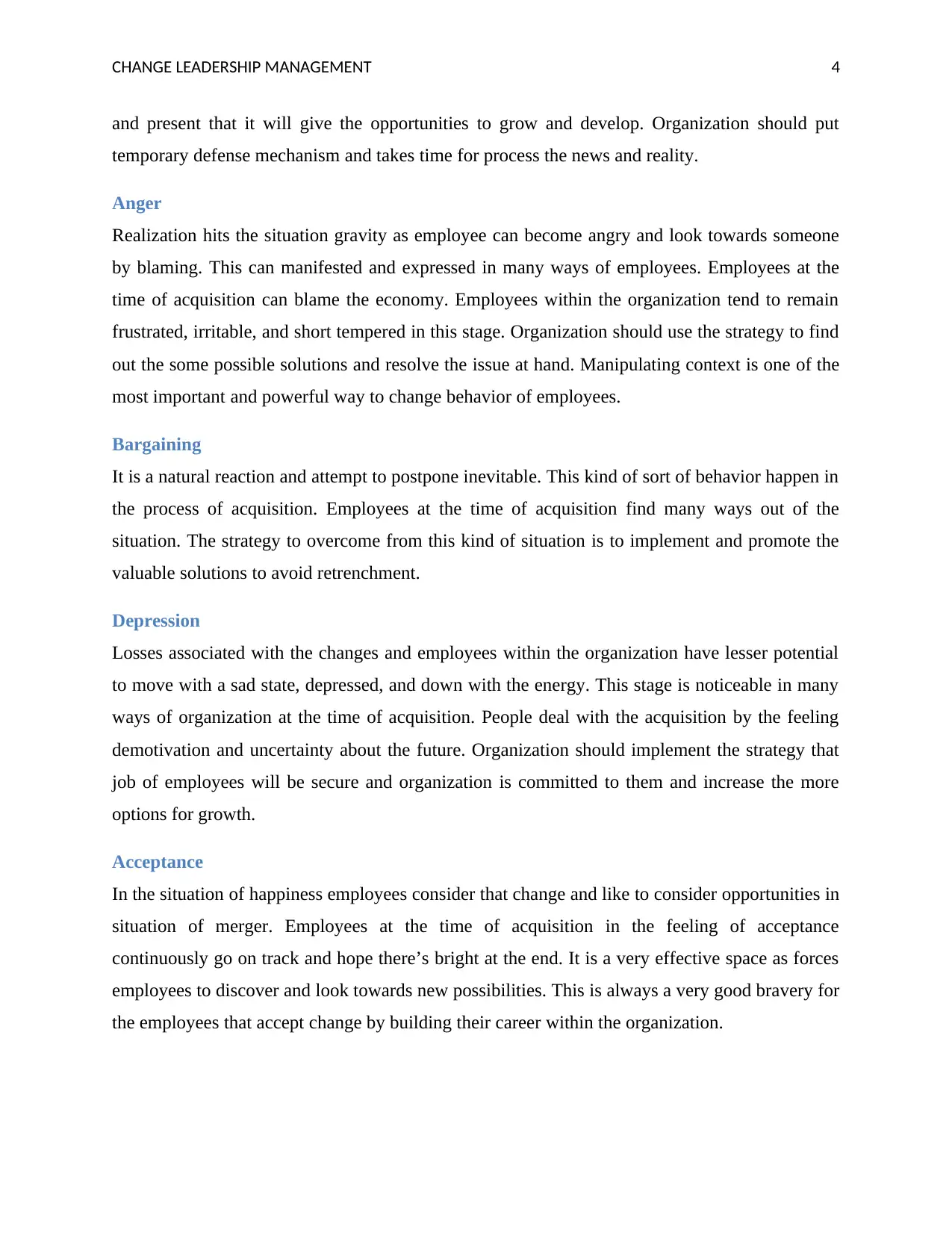
CHANGE LEADERSHIP MANAGEMENT 4
and present that it will give the opportunities to grow and develop. Organization should put
temporary defense mechanism and takes time for process the news and reality.
Anger
Realization hits the situation gravity as employee can become angry and look towards someone
by blaming. This can manifested and expressed in many ways of employees. Employees at the
time of acquisition can blame the economy. Employees within the organization tend to remain
frustrated, irritable, and short tempered in this stage. Organization should use the strategy to find
out the some possible solutions and resolve the issue at hand. Manipulating context is one of the
most important and powerful way to change behavior of employees.
Bargaining
It is a natural reaction and attempt to postpone inevitable. This kind of sort of behavior happen in
the process of acquisition. Employees at the time of acquisition find many ways out of the
situation. The strategy to overcome from this kind of situation is to implement and promote the
valuable solutions to avoid retrenchment.
Depression
Losses associated with the changes and employees within the organization have lesser potential
to move with a sad state, depressed, and down with the energy. This stage is noticeable in many
ways of organization at the time of acquisition. People deal with the acquisition by the feeling
demotivation and uncertainty about the future. Organization should implement the strategy that
job of employees will be secure and organization is committed to them and increase the more
options for growth.
Acceptance
In the situation of happiness employees consider that change and like to consider opportunities in
situation of merger. Employees at the time of acquisition in the feeling of acceptance
continuously go on track and hope there’s bright at the end. It is a very effective space as forces
employees to discover and look towards new possibilities. This is always a very good bravery for
the employees that accept change by building their career within the organization.
and present that it will give the opportunities to grow and develop. Organization should put
temporary defense mechanism and takes time for process the news and reality.
Anger
Realization hits the situation gravity as employee can become angry and look towards someone
by blaming. This can manifested and expressed in many ways of employees. Employees at the
time of acquisition can blame the economy. Employees within the organization tend to remain
frustrated, irritable, and short tempered in this stage. Organization should use the strategy to find
out the some possible solutions and resolve the issue at hand. Manipulating context is one of the
most important and powerful way to change behavior of employees.
Bargaining
It is a natural reaction and attempt to postpone inevitable. This kind of sort of behavior happen in
the process of acquisition. Employees at the time of acquisition find many ways out of the
situation. The strategy to overcome from this kind of situation is to implement and promote the
valuable solutions to avoid retrenchment.
Depression
Losses associated with the changes and employees within the organization have lesser potential
to move with a sad state, depressed, and down with the energy. This stage is noticeable in many
ways of organization at the time of acquisition. People deal with the acquisition by the feeling
demotivation and uncertainty about the future. Organization should implement the strategy that
job of employees will be secure and organization is committed to them and increase the more
options for growth.
Acceptance
In the situation of happiness employees consider that change and like to consider opportunities in
situation of merger. Employees at the time of acquisition in the feeling of acceptance
continuously go on track and hope there’s bright at the end. It is a very effective space as forces
employees to discover and look towards new possibilities. This is always a very good bravery for
the employees that accept change by building their career within the organization.
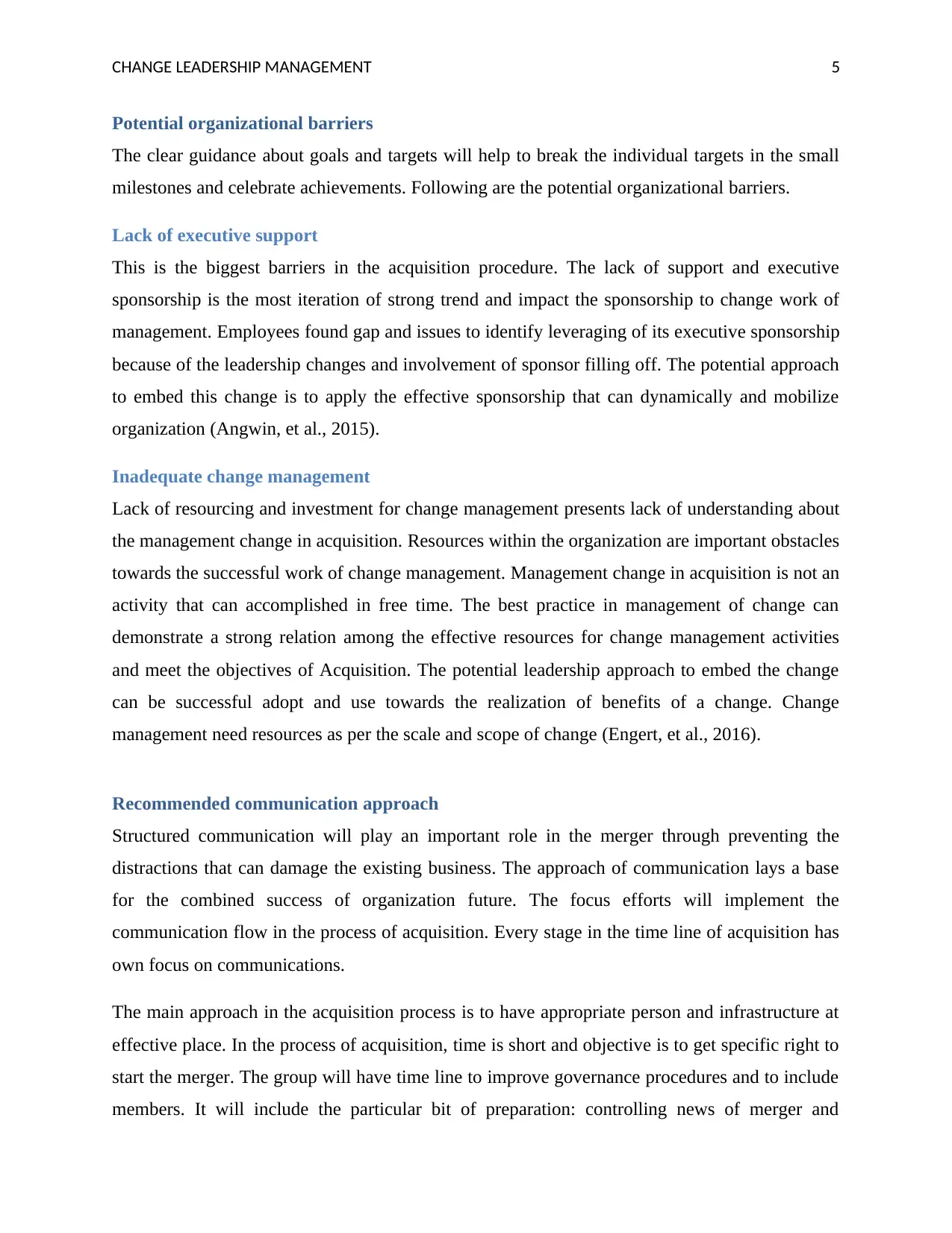
CHANGE LEADERSHIP MANAGEMENT 5
Potential organizational barriers
The clear guidance about goals and targets will help to break the individual targets in the small
milestones and celebrate achievements. Following are the potential organizational barriers.
Lack of executive support
This is the biggest barriers in the acquisition procedure. The lack of support and executive
sponsorship is the most iteration of strong trend and impact the sponsorship to change work of
management. Employees found gap and issues to identify leveraging of its executive sponsorship
because of the leadership changes and involvement of sponsor filling off. The potential approach
to embed this change is to apply the effective sponsorship that can dynamically and mobilize
organization (Angwin, et al., 2015).
Inadequate change management
Lack of resourcing and investment for change management presents lack of understanding about
the management change in acquisition. Resources within the organization are important obstacles
towards the successful work of change management. Management change in acquisition is not an
activity that can accomplished in free time. The best practice in management of change can
demonstrate a strong relation among the effective resources for change management activities
and meet the objectives of Acquisition. The potential leadership approach to embed the change
can be successful adopt and use towards the realization of benefits of a change. Change
management need resources as per the scale and scope of change (Engert, et al., 2016).
Recommended communication approach
Structured communication will play an important role in the merger through preventing the
distractions that can damage the existing business. The approach of communication lays a base
for the combined success of organization future. The focus efforts will implement the
communication flow in the process of acquisition. Every stage in the time line of acquisition has
own focus on communications.
The main approach in the acquisition process is to have appropriate person and infrastructure at
effective place. In the process of acquisition, time is short and objective is to get specific right to
start the merger. The group will have time line to improve governance procedures and to include
members. It will include the particular bit of preparation: controlling news of merger and
Potential organizational barriers
The clear guidance about goals and targets will help to break the individual targets in the small
milestones and celebrate achievements. Following are the potential organizational barriers.
Lack of executive support
This is the biggest barriers in the acquisition procedure. The lack of support and executive
sponsorship is the most iteration of strong trend and impact the sponsorship to change work of
management. Employees found gap and issues to identify leveraging of its executive sponsorship
because of the leadership changes and involvement of sponsor filling off. The potential approach
to embed this change is to apply the effective sponsorship that can dynamically and mobilize
organization (Angwin, et al., 2015).
Inadequate change management
Lack of resourcing and investment for change management presents lack of understanding about
the management change in acquisition. Resources within the organization are important obstacles
towards the successful work of change management. Management change in acquisition is not an
activity that can accomplished in free time. The best practice in management of change can
demonstrate a strong relation among the effective resources for change management activities
and meet the objectives of Acquisition. The potential leadership approach to embed the change
can be successful adopt and use towards the realization of benefits of a change. Change
management need resources as per the scale and scope of change (Engert, et al., 2016).
Recommended communication approach
Structured communication will play an important role in the merger through preventing the
distractions that can damage the existing business. The approach of communication lays a base
for the combined success of organization future. The focus efforts will implement the
communication flow in the process of acquisition. Every stage in the time line of acquisition has
own focus on communications.
The main approach in the acquisition process is to have appropriate person and infrastructure at
effective place. In the process of acquisition, time is short and objective is to get specific right to
start the merger. The group will have time line to improve governance procedures and to include
members. It will include the particular bit of preparation: controlling news of merger and
⊘ This is a preview!⊘
Do you want full access?
Subscribe today to unlock all pages.

Trusted by 1+ million students worldwide
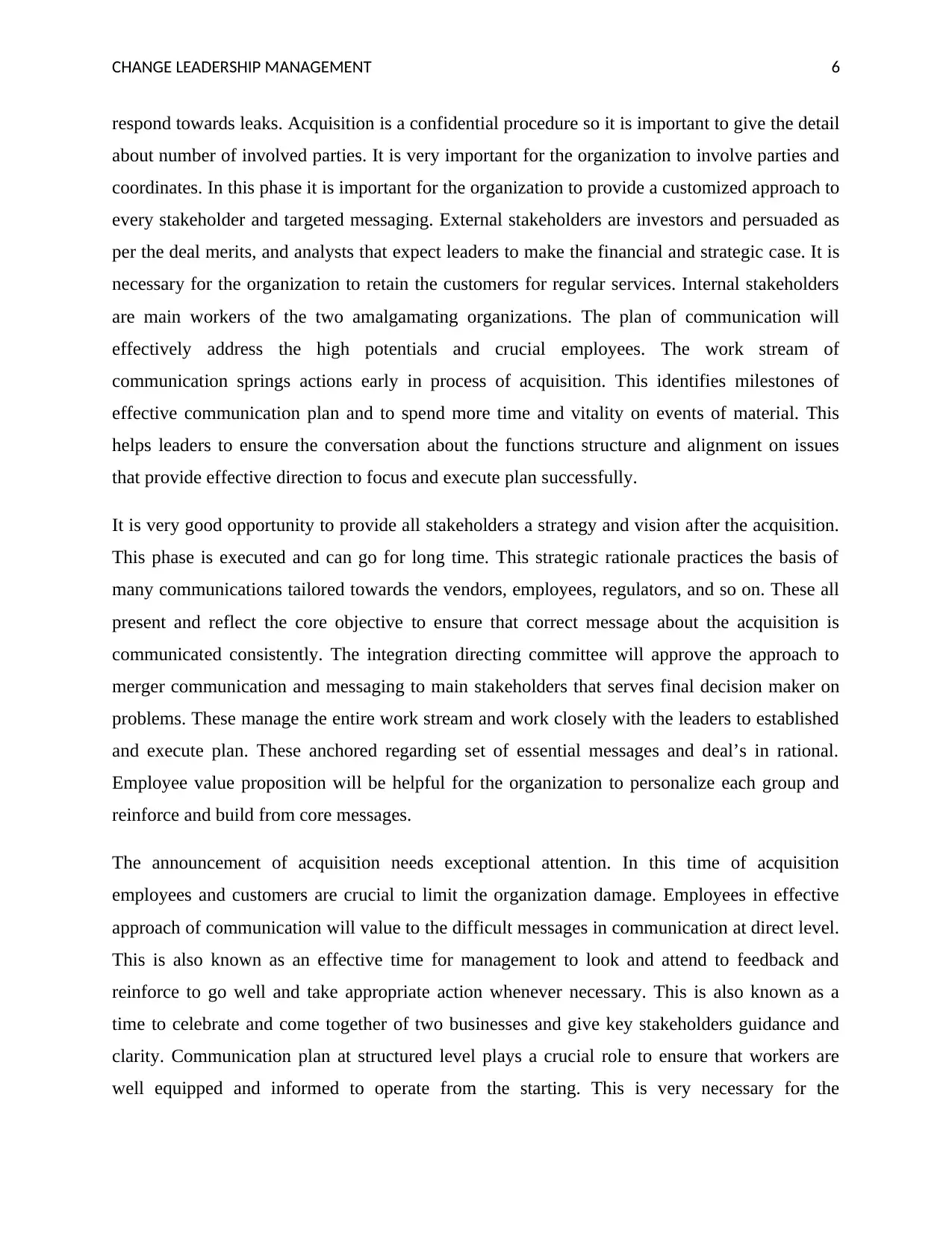
CHANGE LEADERSHIP MANAGEMENT 6
respond towards leaks. Acquisition is a confidential procedure so it is important to give the detail
about number of involved parties. It is very important for the organization to involve parties and
coordinates. In this phase it is important for the organization to provide a customized approach to
every stakeholder and targeted messaging. External stakeholders are investors and persuaded as
per the deal merits, and analysts that expect leaders to make the financial and strategic case. It is
necessary for the organization to retain the customers for regular services. Internal stakeholders
are main workers of the two amalgamating organizations. The plan of communication will
effectively address the high potentials and crucial employees. The work stream of
communication springs actions early in process of acquisition. This identifies milestones of
effective communication plan and to spend more time and vitality on events of material. This
helps leaders to ensure the conversation about the functions structure and alignment on issues
that provide effective direction to focus and execute plan successfully.
It is very good opportunity to provide all stakeholders a strategy and vision after the acquisition.
This phase is executed and can go for long time. This strategic rationale practices the basis of
many communications tailored towards the vendors, employees, regulators, and so on. These all
present and reflect the core objective to ensure that correct message about the acquisition is
communicated consistently. The integration directing committee will approve the approach to
merger communication and messaging to main stakeholders that serves final decision maker on
problems. These manage the entire work stream and work closely with the leaders to established
and execute plan. These anchored regarding set of essential messages and deal’s in rational.
Employee value proposition will be helpful for the organization to personalize each group and
reinforce and build from core messages.
The announcement of acquisition needs exceptional attention. In this time of acquisition
employees and customers are crucial to limit the organization damage. Employees in effective
approach of communication will value to the difficult messages in communication at direct level.
This is also known as an effective time for management to look and attend to feedback and
reinforce to go well and take appropriate action whenever necessary. This is also known as a
time to celebrate and come together of two businesses and give key stakeholders guidance and
clarity. Communication plan at structured level plays a crucial role to ensure that workers are
well equipped and informed to operate from the starting. This is very necessary for the
respond towards leaks. Acquisition is a confidential procedure so it is important to give the detail
about number of involved parties. It is very important for the organization to involve parties and
coordinates. In this phase it is important for the organization to provide a customized approach to
every stakeholder and targeted messaging. External stakeholders are investors and persuaded as
per the deal merits, and analysts that expect leaders to make the financial and strategic case. It is
necessary for the organization to retain the customers for regular services. Internal stakeholders
are main workers of the two amalgamating organizations. The plan of communication will
effectively address the high potentials and crucial employees. The work stream of
communication springs actions early in process of acquisition. This identifies milestones of
effective communication plan and to spend more time and vitality on events of material. This
helps leaders to ensure the conversation about the functions structure and alignment on issues
that provide effective direction to focus and execute plan successfully.
It is very good opportunity to provide all stakeholders a strategy and vision after the acquisition.
This phase is executed and can go for long time. This strategic rationale practices the basis of
many communications tailored towards the vendors, employees, regulators, and so on. These all
present and reflect the core objective to ensure that correct message about the acquisition is
communicated consistently. The integration directing committee will approve the approach to
merger communication and messaging to main stakeholders that serves final decision maker on
problems. These manage the entire work stream and work closely with the leaders to established
and execute plan. These anchored regarding set of essential messages and deal’s in rational.
Employee value proposition will be helpful for the organization to personalize each group and
reinforce and build from core messages.
The announcement of acquisition needs exceptional attention. In this time of acquisition
employees and customers are crucial to limit the organization damage. Employees in effective
approach of communication will value to the difficult messages in communication at direct level.
This is also known as an effective time for management to look and attend to feedback and
reinforce to go well and take appropriate action whenever necessary. This is also known as a
time to celebrate and come together of two businesses and give key stakeholders guidance and
clarity. Communication plan at structured level plays a crucial role to ensure that workers are
well equipped and informed to operate from the starting. This is very necessary for the
Paraphrase This Document
Need a fresh take? Get an instant paraphrase of this document with our AI Paraphraser
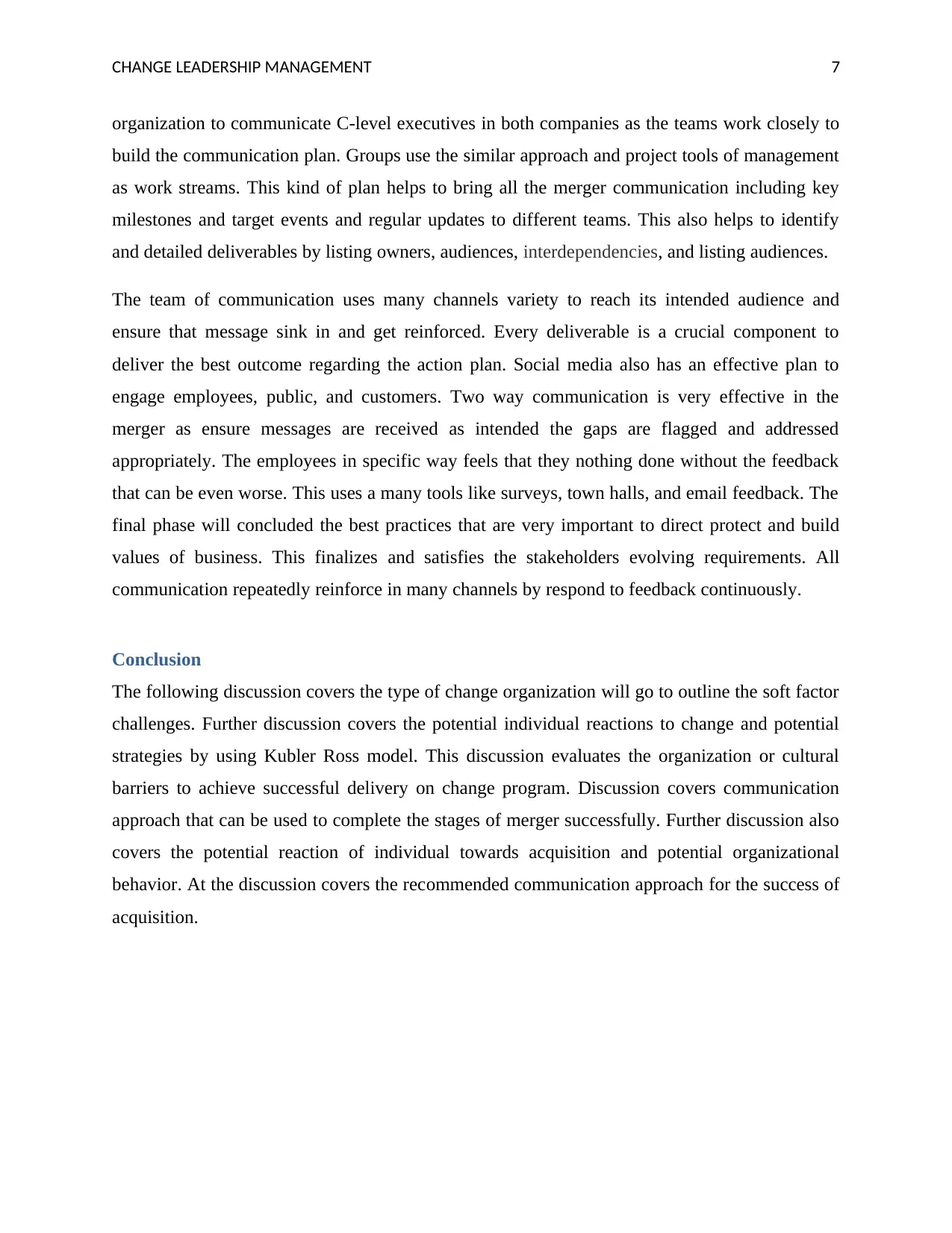
CHANGE LEADERSHIP MANAGEMENT 7
organization to communicate C-level executives in both companies as the teams work closely to
build the communication plan. Groups use the similar approach and project tools of management
as work streams. This kind of plan helps to bring all the merger communication including key
milestones and target events and regular updates to different teams. This also helps to identify
and detailed deliverables by listing owners, audiences, interdependencies, and listing audiences.
The team of communication uses many channels variety to reach its intended audience and
ensure that message sink in and get reinforced. Every deliverable is a crucial component to
deliver the best outcome regarding the action plan. Social media also has an effective plan to
engage employees, public, and customers. Two way communication is very effective in the
merger as ensure messages are received as intended the gaps are flagged and addressed
appropriately. The employees in specific way feels that they nothing done without the feedback
that can be even worse. This uses a many tools like surveys, town halls, and email feedback. The
final phase will concluded the best practices that are very important to direct protect and build
values of business. This finalizes and satisfies the stakeholders evolving requirements. All
communication repeatedly reinforce in many channels by respond to feedback continuously.
Conclusion
The following discussion covers the type of change organization will go to outline the soft factor
challenges. Further discussion covers the potential individual reactions to change and potential
strategies by using Kubler Ross model. This discussion evaluates the organization or cultural
barriers to achieve successful delivery on change program. Discussion covers communication
approach that can be used to complete the stages of merger successfully. Further discussion also
covers the potential reaction of individual towards acquisition and potential organizational
behavior. At the discussion covers the recommended communication approach for the success of
acquisition.
organization to communicate C-level executives in both companies as the teams work closely to
build the communication plan. Groups use the similar approach and project tools of management
as work streams. This kind of plan helps to bring all the merger communication including key
milestones and target events and regular updates to different teams. This also helps to identify
and detailed deliverables by listing owners, audiences, interdependencies, and listing audiences.
The team of communication uses many channels variety to reach its intended audience and
ensure that message sink in and get reinforced. Every deliverable is a crucial component to
deliver the best outcome regarding the action plan. Social media also has an effective plan to
engage employees, public, and customers. Two way communication is very effective in the
merger as ensure messages are received as intended the gaps are flagged and addressed
appropriately. The employees in specific way feels that they nothing done without the feedback
that can be even worse. This uses a many tools like surveys, town halls, and email feedback. The
final phase will concluded the best practices that are very important to direct protect and build
values of business. This finalizes and satisfies the stakeholders evolving requirements. All
communication repeatedly reinforce in many channels by respond to feedback continuously.
Conclusion
The following discussion covers the type of change organization will go to outline the soft factor
challenges. Further discussion covers the potential individual reactions to change and potential
strategies by using Kubler Ross model. This discussion evaluates the organization or cultural
barriers to achieve successful delivery on change program. Discussion covers communication
approach that can be used to complete the stages of merger successfully. Further discussion also
covers the potential reaction of individual towards acquisition and potential organizational
behavior. At the discussion covers the recommended communication approach for the success of
acquisition.
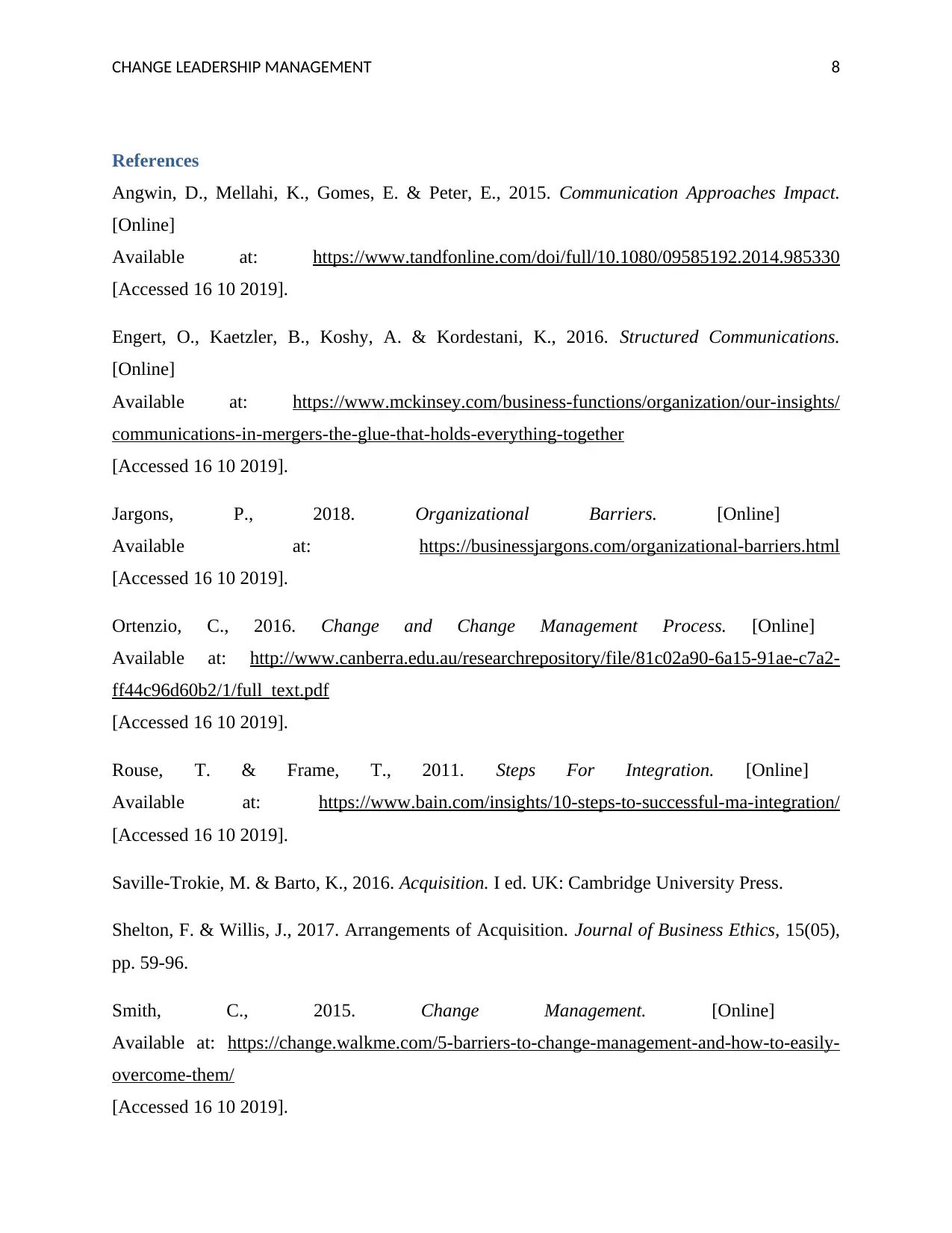
CHANGE LEADERSHIP MANAGEMENT 8
References
Angwin, D., Mellahi, K., Gomes, E. & Peter, E., 2015. Communication Approaches Impact.
[Online]
Available at: https://www.tandfonline.com/doi/full/10.1080/09585192.2014.985330
[Accessed 16 10 2019].
Engert, O., Kaetzler, B., Koshy, A. & Kordestani, K., 2016. Structured Communications.
[Online]
Available at: https://www.mckinsey.com/business-functions/organization/our-insights/
communications-in-mergers-the-glue-that-holds-everything-together
[Accessed 16 10 2019].
Jargons, P., 2018. Organizational Barriers. [Online]
Available at: https://businessjargons.com/organizational-barriers.html
[Accessed 16 10 2019].
Ortenzio, C., 2016. Change and Change Management Process. [Online]
Available at: http://www.canberra.edu.au/researchrepository/file/81c02a90-6a15-91ae-c7a2-
ff44c96d60b2/1/full_text.pdf
[Accessed 16 10 2019].
Rouse, T. & Frame, T., 2011. Steps For Integration. [Online]
Available at: https://www.bain.com/insights/10-steps-to-successful-ma-integration/
[Accessed 16 10 2019].
Saville-Trokie, M. & Barto, K., 2016. Acquisition. I ed. UK: Cambridge University Press.
Shelton, F. & Willis, J., 2017. Arrangements of Acquisition. Journal of Business Ethics, 15(05),
pp. 59-96.
Smith, C., 2015. Change Management. [Online]
Available at: https://change.walkme.com/5-barriers-to-change-management-and-how-to-easily-
overcome-them/
[Accessed 16 10 2019].
References
Angwin, D., Mellahi, K., Gomes, E. & Peter, E., 2015. Communication Approaches Impact.
[Online]
Available at: https://www.tandfonline.com/doi/full/10.1080/09585192.2014.985330
[Accessed 16 10 2019].
Engert, O., Kaetzler, B., Koshy, A. & Kordestani, K., 2016. Structured Communications.
[Online]
Available at: https://www.mckinsey.com/business-functions/organization/our-insights/
communications-in-mergers-the-glue-that-holds-everything-together
[Accessed 16 10 2019].
Jargons, P., 2018. Organizational Barriers. [Online]
Available at: https://businessjargons.com/organizational-barriers.html
[Accessed 16 10 2019].
Ortenzio, C., 2016. Change and Change Management Process. [Online]
Available at: http://www.canberra.edu.au/researchrepository/file/81c02a90-6a15-91ae-c7a2-
ff44c96d60b2/1/full_text.pdf
[Accessed 16 10 2019].
Rouse, T. & Frame, T., 2011. Steps For Integration. [Online]
Available at: https://www.bain.com/insights/10-steps-to-successful-ma-integration/
[Accessed 16 10 2019].
Saville-Trokie, M. & Barto, K., 2016. Acquisition. I ed. UK: Cambridge University Press.
Shelton, F. & Willis, J., 2017. Arrangements of Acquisition. Journal of Business Ethics, 15(05),
pp. 59-96.
Smith, C., 2015. Change Management. [Online]
Available at: https://change.walkme.com/5-barriers-to-change-management-and-how-to-easily-
overcome-them/
[Accessed 16 10 2019].
⊘ This is a preview!⊘
Do you want full access?
Subscribe today to unlock all pages.

Trusted by 1+ million students worldwide
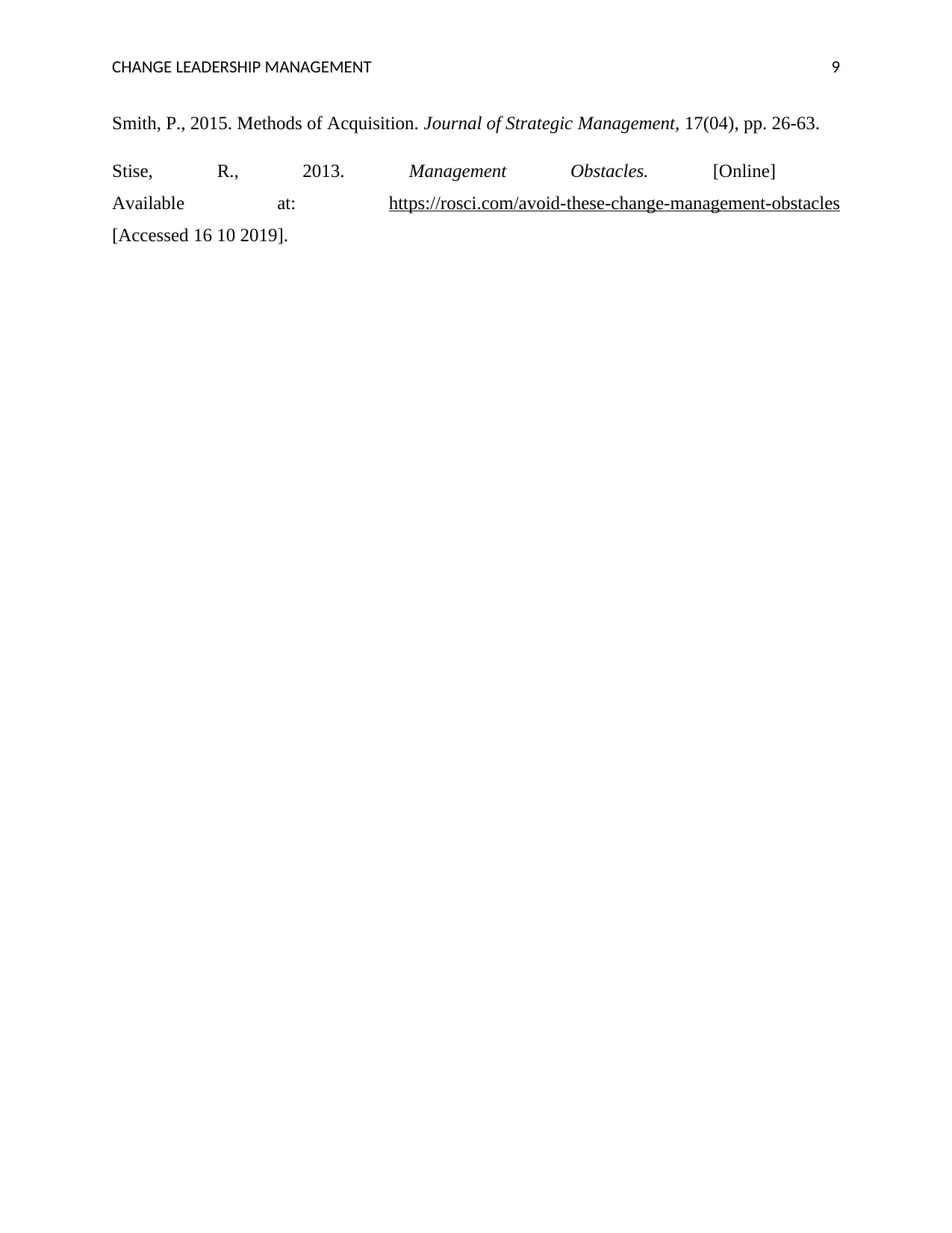
CHANGE LEADERSHIP MANAGEMENT 9
Smith, P., 2015. Methods of Acquisition. Journal of Strategic Management, 17(04), pp. 26-63.
Stise, R., 2013. Management Obstacles. [Online]
Available at: https://rosci.com/avoid-these-change-management-obstacles
[Accessed 16 10 2019].
Smith, P., 2015. Methods of Acquisition. Journal of Strategic Management, 17(04), pp. 26-63.
Stise, R., 2013. Management Obstacles. [Online]
Available at: https://rosci.com/avoid-these-change-management-obstacles
[Accessed 16 10 2019].
1 out of 10
Related Documents
Your All-in-One AI-Powered Toolkit for Academic Success.
+13062052269
info@desklib.com
Available 24*7 on WhatsApp / Email
![[object Object]](/_next/static/media/star-bottom.7253800d.svg)
Unlock your academic potential
Copyright © 2020–2025 A2Z Services. All Rights Reserved. Developed and managed by ZUCOL.



